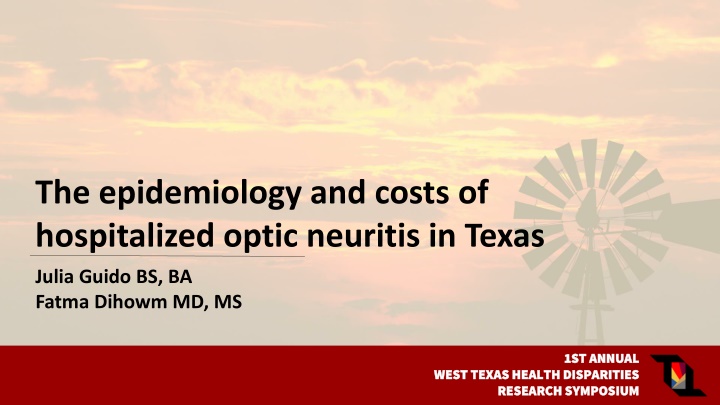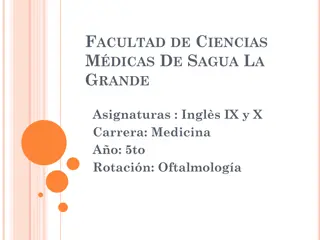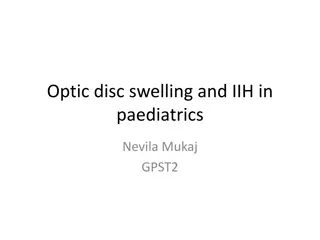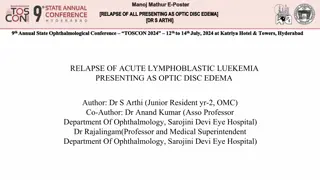Epidemiology and Costs of Hospitalized Optic Neuritis in Texas
This study explores the epidemiology and associated costs of hospitalized optic neuritis in Texas, presented at the 1st Annual West Texas Health Disparities Research Symposium. The research provides valuable insights into the burden of optic neuritis on healthcare resources and the implications for public health strategies.
Download Presentation

Please find below an Image/Link to download the presentation.
The content on the website is provided AS IS for your information and personal use only. It may not be sold, licensed, or shared on other websites without obtaining consent from the author.If you encounter any issues during the download, it is possible that the publisher has removed the file from their server.
You are allowed to download the files provided on this website for personal or commercial use, subject to the condition that they are used lawfully. All files are the property of their respective owners.
The content on the website is provided AS IS for your information and personal use only. It may not be sold, licensed, or shared on other websites without obtaining consent from the author.
E N D
Presentation Transcript
The epidemiology and costs of hospitalized optic neuritis in Texas Julia Guido BS, BA Fatma Dihowm MD, MS 1ST ANNUAL 1ST ANNUAL WEST TEXAS HEALTH DISPARITIES WEST TEXAS HEALTH DISPARITIES RESEARCH SYMPOSIUM RESEARCH SYMPOSIUM
1ST ANNUAL WEST TEXAS HEALTH DISPARITIES RESEARCH SYMPOSIUM DISCLOSURES Nothing to disclose
1ST ANNUAL WEST TEXAS HEALTH DISPARITIES RESEARCH SYMPOSIUM Introduction Purpose: to examine the effects and cost burden of optic neuritis for inpatient cases in Texas, with a focus on Hispanic patients and patients living in border cities. By conducting this study, we hope to contribute to the knowledge on optic neuritis and provide insights into how healthcare policy can be improved to reduce the cost burden of the disease for vulnerable populations.
1ST ANNUAL WEST TEXAS HEALTH DISPARITIES RESEARCH SYMPOSIUM Methods ICD10 codes for optic neuritis Texas Inpatient Public Use Data File 2020-2021 Analyzing demographic trends as compared to costs
1ST ANNUAL Results Hispanic patients and border cities WEST TEXAS HEALTH DISPARITIES RESEARCH SYMPOSIUM Border Cities Non-Border Cities Patients who identify as Hispanic 49.79% 18.55%
1ST ANNUAL WEST TEXAS HEALTH DISPARITIES RESEARCH SYMPOSIUM Results 1,196 total patients were diagnosed with optic neuritis from 2020-2021 Hispanic patients were diagnosed younger Age 18-34 35-49 50-64 65+ Non-Hispanic patients 26.00% 29.22% 27.44% 17.33% Hispanic Patients 40.00% 29.49% 20.68% 9.83%
1ST ANNUAL WEST TEXAS HEALTH DISPARITIES RESEARCH SYMPOSIUM Results Patients in border cities were more likely to have an associated multiple sclerosis diagnosis Border Cities Non-Border Cities Associated diagnosis of Multiple Sclerosis 33.47% 27.08%
1ST ANNUAL WEST TEXAS HEALTH DISPARITIES RESEARCH SYMPOSIUM Results Semi-private room, ward, MRI, and ER charges were higher for Hispanic patients While private rooms were more expensive in non-border cities, total charges were higher for border cities semi-private room PT/OT end stage renal dialysis costs
1ST ANNUAL WEST TEXAS HEALTH DISPARITIES RESEARCH SYMPOSIUM Results Insurance type by ethnicity Hispanic Patients Non-Hispanic Patients Private/self-pay insurance 40% 51.89% Medicaid/Federal insurance 30.85% 23% Other/unknown insurance 29.15% 15.11%
1ST ANNUAL WEST TEXAS HEALTH DISPARITIES RESEARCH SYMPOSIUM Discussion Hispanic patients are significantly less likely to pay by private/self- pay insurance and more likely to be classified under other/unknown suggesting a lack of access and coverage and greater out of pocket expenses Lack of insurance coverage can lead to less frequent care and increased mortality (Canedo et al.) Younger age of diagnosis for Hispanic patients leads to more years of complications, hospital visits, payments, and medication usage, further exacerbating the cost of optic neuritis
1ST ANNUAL WEST TEXAS HEALTH DISPARITIES RESEARCH SYMPOSIUM Discussion Hispanic patients and patients living in border cities are more likely to be diagnosed with comorbid multiple sclerosis Higher costs (Adelman et al) Already limited access to care Hispanic patients pay more for private and semi-private room, wards, and imaging. These higher costs could be related to the disparities in insurance coverage, as a patient who is uninsured is likely to pay significantly more out of pocket than a patient with private or federal insurance.
1ST ANNUAL WEST TEXAS HEALTH DISPARITIES RESEARCH SYMPOSIUM Conclusion Hispanic patients and patients living in border cities are vulnerable populations with higher costs and limited access to care These factors could lead to worse outcomes for patients, who will then need to spend more on medical care, furthering the cycle
1ST ANNUAL WEST TEXAS HEALTH DISPARITIES RESEARCH SYMPOSIUM Conclusion These findings demonstrate a clear need for targeted interventions to address the healthcare disparities that Hispanic and border-city patients face with optic neuritis treatment Further research should focus on exploring additional contributing factors to the costs of hospitalized optic neuritis and potential strategies to improve outcomes for this patient population
1ST ANNUAL WEST TEXAS HEALTH DISPARITIES RESEARCH SYMPOSIUM Thank you!
1ST ANNUAL WEST TEXAS HEALTH DISPARITIES RESEARCH SYMPOSIUM References 1. Adelman, G., Rane, S. G., & Villa, K. F. (2013). The cost burden of multiple sclerosis in the United States: a systematic review of the literature. Journal of medical economics, 16(5), 639 647. https://doi.org/10.3111/13696998.2013.778268 Basu, J., Hanchate, A., & Bierman, A. (2018). Racial/Ethnic Disparities in Readmissions in US Hospitals: The Role of Insurance Coverage. Inquiry : a journal of medical care organization, provision and financing, 55, 46958018774180. https://doi.org/10.1177/0046958018774180 Battaglia, M. A., Bezzini, D., Cecchini, I., Cordioli, C., Fiorentino, F., Manacorda, T., Nica, M., Ponzio, M., Ritrovato, D., Vassallo, C., & Patti, F. (2022). Patients with multiple sclerosis: a burden and cost of illness study. Journal of neurology, 269(9), 5127 5135. https://doi.org/10.1007/s00415-022-11169-w Canedo, J. R., Miller, S. T., Schlundt, D., Fadden, M. K., & Sanderson, M. (2018). Racial/Ethnic Disparities in Diabetes Quality of Care: the Role of Healthcare Access and Socioeconomic Status. Journal of racial and ethnic health disparities, 5(1), 7 14. https://doi.org/10.1007/s40615-016-0335-8 Cha, A. E., & Cohen, R. A. (2022). Demographic Variation in Health Insurance Coverage:United States, 2021. National health statistics reports, (177), 1 14. Exuzides, A., Sheinson, D., Sidiropoulos, P., Magrini, F., Gholizadeh, S., Surinach, A., Cook, L., Meyer, C. S., & Yeaman, M. (2021). Burden and cost of comorbidities in patients with neuromyelitis optica spectrum disorder. Journal of the neurological sciences, 427, 117530. https://doi.org/10.1016/j.jns.2021.117530 Hughes, D. A., Bourke, S., Jones, A., Bhatt, R., Huda, S., Mutch, K., & Jacob, A. (2022). Health utilities and costs for neuromyelitis optica spectrum disorder. Orphanet journal of rare diseases, 17(1), 159. https://doi.org/10.1186/s13023-022-02310-z de Heer, H. D., Balc zar, H. G., Morera, O. F., Lapeyrouse, L., Heyman, J. M., Salinas, J., & Zambrana, R. E. (2013). Barriers to care and comorbidities along the U.S.-Mexico border. Public health reports (Washington, D.C. : 1974), 128(6), 480 488. Jennum, P., Frederiksen, J. L., Wanscher, B., & Kjellberg, J. (2013). The socioeconomic consequences of optic neuritis with and without multiple sclerosis: a controlled national study. Acta neurologica Scandinavica, 127(4), 242 250. https://doi.org/10.1111/j.1600-0404.2012.01703.x Optic neuritis: Pathophysiology, clinical features, and diagnosis. In: UpToDate, Post TW (Ed), UpToDate, Waltham, MA. (Accessed on April 04, 2023.) Ruiz-Beltran, M., & Kamau, J. K. (2001). The socio-economic and cultural impediments to well-being along the US-Mexico border. Journal of community health, 26(2), 123 132. https://doi.org/10.1023/a:1005229330204 Sawalha, K., Adeodokun, S., & Kamoga, G. R. (2020). COVID-19-Induced Acute Bilateral Optic Neuritis. Journal of investigative medicine high impact case reports, 8, 2324709620976018. https://doi.org/10.1177/2324709620976018 Sriwastava, S., Tandon, M., Podury, S., Prasad, A., Wen, S., Guthrie, G., Kakara, M., Jaiswal, S., Subedi, R., Elkhooly, M., & Lisak, R. P. (2021). COVID-19 and neuroinflammation: a literature review of relevant neuroimaging and CSF markers in central nervous system inflammatory disorders from SARS-COV2. Journal of neurology, 268(12), 4448 4478. https://doi.org/10.1007/s00415-021-10611-9 Wherry, L., & Finegold, K. (2004). Changes in health insurance coverage and health status by race and ethnicity, 1997-2002. Journal of the National Medical Association, 96(12), 1577 1582. 2. 3. 4. 5. 6. 7. 8. 9. 10. 11. 12. 13. 14.























